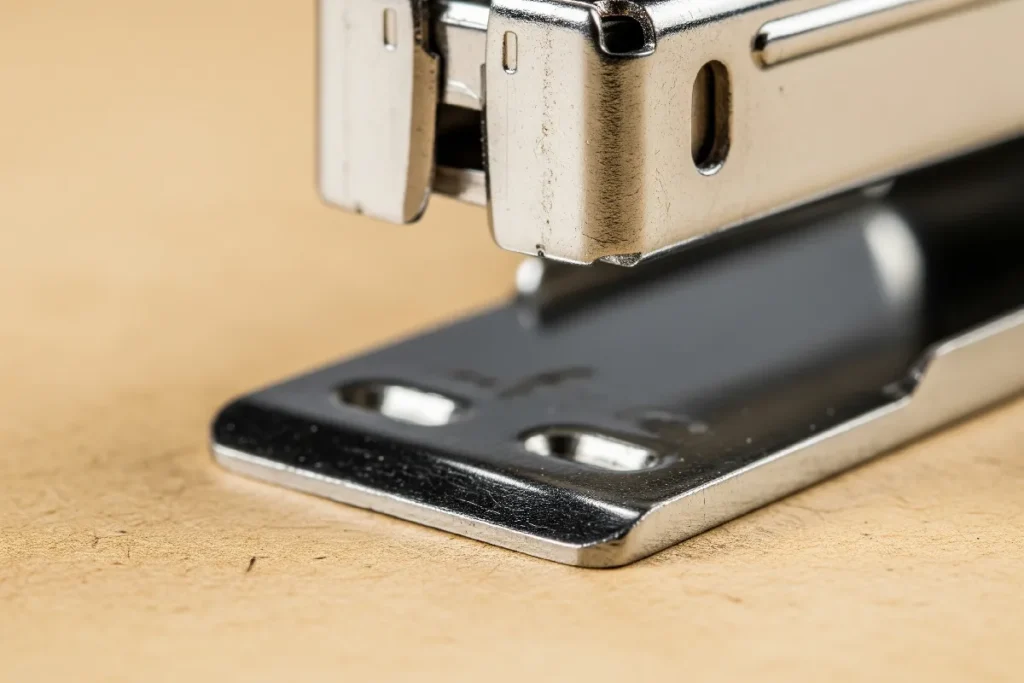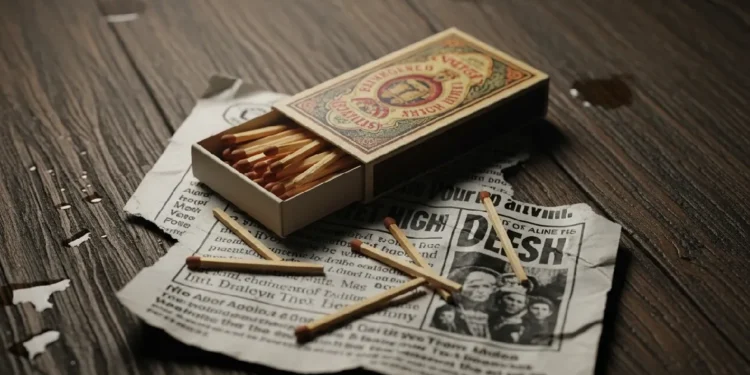A cultural microhistory of the stapler, revealing how this mundane fastening tool helped build paperwork power, streamline authority, and become a quiet emblem in acts of everyday resistance.
Table of Contents
Introduction
The history of the stapler is a story of silent, immense power, hidden in the most mundane object on your desk. We see it as a simple tool, a mechanism for binding loose pages with a satisfying, metallic crunch. Yet, this perception masks its true role as a crucial agent in the construction of the modern world. It is a story of bureaucratic empires built, of authority streamlined, and of quiet rebellions waged in the beige landscape of the office cubicle. This humble fastener is far more than a tool for convenience; it is a cultural artifact that both forged and defied the very systems it was designed to serve.
Before its invention, the world was drowning in paper. Official documents were held together by precarious and inefficient means—wax seals that crumbled, ribbons that frayed, and straight pins that pricked and snagged. As the Industrial Revolution fueled the explosive growth of corporations and government bodies, this paper chaos became an existential threat to institutional control and scalability. The urgent search for a permanent, mechanical fastener was, therefore, a search for the very soul of bureaucracy: a tool that could impose immutable order and forge empires from stacks of loose-leaf paper, securing information and, with it, power.
This article deconstructs the complete history of the stapler, tracing its evolution from its origins as a novelty item to its current role as an indispensable component in the machinery of institutional control. We will analyze how it enabled the standardization of paperwork and became a symbol of officialdom. But we will then pivot to explore the flawed history of the stapler—the one that ignores its second life as an instrument of everyday workplace dissent. Finally, we examine its fading relevance in our digital age, questioning its legacy. Join us as we reveal how the most overlooked object in the office tells the secret story of control and defiance.
Before the Bind: Paper Chaos and the Quest for Order
Long before the satisfying crunch of a stapler, the office was a realm of precarious connections. In the pre-industrial world, binding documents was a clumsy, impermanent affair. Clerks and scribes relied on a motley crew of fasteners: delicate ribbons threaded through punched holes, brittle wax seals that could crumble with a careless touch, and sharp, straight pins that pricked fingers and snagged sleeves. Each method was a temporary fix for a permanent problem. These early attempts to impose order were tactile and personal, but they were also fundamentally unreliable, creating administrative bottlenecks that hindered the flow of information and commerce.
This ad-hoc system began to buckle under the weight of its own inefficiency during the Industrial Revolution. As corporations expanded and government bureaucracies swelled, the trickle of paperwork became a deluge. The old ways were no longer quaint; they were a direct threat to scalability and control. A multi-page contract held by a single pin or a financial ledger tied with ribbon was a fragile artifact in an ecosystem that increasingly demanded permanence and precision. The growing need for a robust, mechanical solution set the stage for a new chapter in office technology, a chapter that would define the early history of the stapler.
The problem, however, was not merely physical; it was philosophical. Loose papers represented a loose grip on institutional knowledge and, by extension, on power itself. For a burgeoning bureaucracy to function, to standardize its processes and centralize its authority, it needed to control its data. The inability to permanently bind related documents—to create a single, immutable unit from disparate pages—was a critical vulnerability. The quest for a better fastener was, therefore, a quest for a tool that could tame paper chaos and, in doing so, solidify the very structures of institutional control.

Forging the First Fastener: The Official History of the Stapler
The conventional history of the stapler often begins with a flourish of royal novelty. An early, single-use fastening device is said to have been crafted for King Louis XV of France, a bespoke tool for binding court documents with a regal, metallic seal. While this story positions the stapler’s origins in the halls of absolute power, it frames the invention as a mere curiosity. The true genesis of the modern stapler lies not in aristocratic whim but in the grimy, industrious workshops of the 19th century, where the demand for efficiency was creating a new class of mechanical problem-solvers. This is where the practical stapler invention history truly begins.
The late 1800s saw a flurry of patents that moved the paper fastener from a luxury object to a mass-market tool. The Novelty Manufacturing Company’s single-stroke device and George McGill’s 1879 patent for a machine that could insert and clinch a staple in one motion were pivotal moments. These advancements did not happen in a vacuum; they were part of a broader office technology timeline that included the commercial typewriter and the vertical filing cabinet. The stapler was another gear in this new machine of efficiency, designed to mechanize and accelerate the flow of paper, the lifeblood of the modern corporation.
Yet, to credit a few great inventors is to accept a flawed history of the stapler. The device’s evolution was not a series of isolated eurekas but a messy, iterative process driven by market competition and the precise needs of burgeoning bureaucracies. Engineers and designers continuously refined the machine, making it smaller, more reliable, and capable of holding more staples. This narrative of gradual improvement, rather than singular genius, offers a more accurate account, revealing how the history of the stapler was shaped less by inventors and more by the institutions it was built to serve.
The Stapler’s Iron Grip: Binding the Bureaucratic Machine
The mass adoption of the stapler marked a pivotal moment in the relationship between stationery and power. More than a mere convenience, it was a revolutionary tool that enabled the standardization and scalability of the modern institution. By transforming loose, vulnerable sheets into a single, secure unit, the stapler allowed for the creation of complex, multi-page documents that could be reliably filed, archived, and controlled. This seemingly small innovation was the missing link that allowed bureaucratic systems to grow exponentially, turning paperwork from a craft into an assembly-line process. The history of the stapler is inseparable from the history of institutional growth.
The simple act of stapling quickly became imbued with symbolic weight, evolving into a small but significant ritual of officialdom. A packet of pages bound by a metal clinch was no longer just a collection of thoughts; it was a report, a contract, a file—a finished product of administrative labor. This physical bond became integral to legal, corporate, and governmental processes, streamlining authority by creating tangible artifacts of policy and procedure. The crisp puncture and fold of the staple was the final, mechanical seal of approval that legitimized the information within, transforming abstract data into an official record.
Ultimately, we must analyze the profound consequences of the history of the stapler. This tool did not merely organize the existing paper trail; it helped forge the very workflows and hierarchies that define institutional power today. The ability to bind documents efficiently encouraged the creation of more complex forms, more detailed reports, and deeper, more intricate archives. The stapler’s iron grip didn’t just hold paper together; it helped construct the rigid, document-centric reality of modern bureaucracy, ensuring that power was not only exercised but also meticulously filed and preserved.

Rethinking the History of the Stapler: A Tool of Quiet Dissent
To see the stapler only as a tool of bureaucratic control is to accept a flawed history of the stapler. Once placed in the hands of the individual worker, it transformed into a complex object of material culture—an emblem of both compliance and quiet rebellion. Popular culture swiftly recognized this duality; films like Office Space famously depicted the stapler not as a tool of productivity but as a treasured personal possession, a symbol of identity in a dehumanizing corporate landscape. Its forceful, percussive action also makes it a perfect, low-stakes outlet for workplace frustration, a tiny act of physical defiance against intangible pressures.
This silent dissent manifests in countless subtle ways. The unnecessary double-staple, the mindless punching of a stray piece of paper, or the “accidental” jamming of the machine are micro-aggressions against the very efficiency the tool was designed to promote. Workplace ethnography reveals employees using office staplers for non-sanctioned tasks, from mending personal belongings to creating cubicle art, reclaiming a piece of corporate property for their own use. These acts, though small, represent a powerful undercurrent of resistance, a way to assert individuality and push back against the monotonous demands of institutional life.
By ignoring this dynamic, the official narrative presents a sanitized and incomplete version of events. Rethinking the history of the stapler requires us to see it not just from the top down—as a tool for managers and systems—but from the bottom up. For every document it bound for the archive, it also served as a fidget toy, a miniature weapon, or a symbol of personal space for the employee. This reframes the stapler as a dual-use object, a fascinating artifact caught in the crossfire between corporate order and the unyielding human impulse for autonomy.
The Digital Staple: The Future of Fastening in a Paperless World
In the 21st-century office, awash with cloud storage and collaborative documents, the stapler often seems like a relic. The promise of the “paperless office” has largely been realized through digital workflows that bind information with a click, not a clinch. We merge PDFs, share links, and build databases—all forms of a digital staple that render its mechanical ancestor seemingly obsolete. Its once-critical function has been usurped by invisible code, leading one to question whether the stapler’s long, impactful history is finally coming to a quiet end, its utility diminished to the point of extinction.
Yet, reports of its death are greatly exaggerated. Paper persists stubbornly in sectors where physicality still signifies importance—legal contracts, medical records, and official government documents often require a tangible form. In these realms, the sharp punch of a stapler remains a powerful act, a definitive gesture that a digital signature cannot fully replicate. Even in highly digitized environments, the stapler endures on desks as a symbol of “office-ness,” a weighty, physical tool in an increasingly virtual landscape. Its presence is a tactile link to a long tradition of administrative work.
Ultimately, the future of the stapler may be more symbolic than functional. As we move further into the digital age, its legacy becomes clearer: it was a foundational tool of the analog era, a simple machine that helped build the complex world of modern bureaucracy. The ongoing history of the stapler is now one of transformation from an essential device to a cultural artifact. It serves as a potent object in our collective memory of work, a humble reminder of the physical effort that once went into binding power, one page at a time.

Conclusion
We have traced the remarkable journey of a seemingly insignificant object, revealing how the history of the stapler is deeply intertwined with the rise of modern power structures. From the chaotic, pre-industrial office where paper was precariously managed, the stapler emerged as a revolutionary tool of order. It was not merely an invention for convenience but a critical instrument that allowed bureaucratic systems to scale, standardizing the flow of information and binding the machinery of institutional authority with a grip of cold, hard steel.
However, the complete history of the stapler cannot be told from the perspective of power alone. This essay has reaffirmed that once a tool is placed in the hands of the individual, its purpose is renegotiated. For every document it officially bound, the stapler served as an outlet for workplace frustration, a symbol of personal identity, and a tool for quiet, everyday resistance. This duality is its true legacy: it is an artifact that embodies the perpetual tension between the rigid demands of the system and the unyielding human desire for autonomy.
Therefore, as this analog tool fades into a relic in our digital age, its story serves as a critical lesson. It compels us to look more closely at the mundane technologies that govern our lives today and to question the power they hold. By revealing the stapler’s hidden role in both building institutions and enabling low-profile dissent, we are better equipped to understand how the tools of tomorrow will shape our own acts of compliance and defiance. The most profound histories, after all, are often bound in the most ordinary of things.








